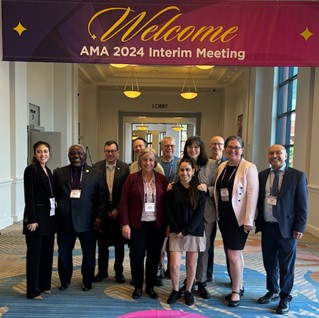Medicare Payment Rates Remains Top Issue for MMA Delegation at AMA Interim Meeting
November 14, 2024
Medicare payment reform topped the list of MMA priorities again at the AMA’s Interim Meeting held November 8-12 in Orlando, Fla.
Those attending for the MMA’s AMA delegation included: Cindy Firkins Smith, MD, delegation chair; JP Abenstein, MD; Edwin Bogonko, MD, MBA; Andrea Hillerud, MD; George Morris, MD; Dennis O’Hare, MD; Ashok Patel, MD; Laurel Ries, MD; and Dave Thorson, MD. MMA CEO Janet Silversmith, and medical student Adrina Kocharian, PhD, and resident Lauren Benning, DO also attended the event.
 |
|
Minnesota was well-represented: Diana Hla, a medical student at Mayo Clinic Alix School of Medicine (left); MMA President Edwin Bogonko, MD, MBA; JP Abenstein, MD; Dennis O'Hare, MD; MMA CEO Janet Silversmith; Dave Thorson, MD; medical student Adrina Kocharian, PhD; Cindy Firkins Smith, MD; George Morris, MD; Laurel Ries, MD; and Ashok Patel, MD.
|
Medicare payment rates, when adjusted for inflation, have fallen by 29% over the past 20 years. Physicians face another 2.83% cut in pay effective January 1, 2025, unless Congress intervenes.
As a result of AMA advocacy, a bipartisan group in the U.S. House of Representatives has introduced a bill that would eliminate the 2.8% Medicare physician payment cut slated for January 1, 2025, and provide a 1.8% positive payment update that is equal to one half of the Medicare Economic Index.
Along with Medicare reform, other top physician priorities at the AMA meeting included: fixing prior authorization; fighting scope creep; reducing physician burnout; and making technology work for physicians.
Resolutions that passed included:
-
A directive to continue to pursue scope of practice issues that put patients at risk, including a resolution specifically preventing non-physicians from performing laser surgery on the eye. The “Scope of Practice” session discussed many state challenges in advancing scope and shared the statistic that currently 60% of nurse practitioner training programs are now 100% online.
-
A resolution that directed the AMA to lobby federal and state leaders to require a board-certified physician to staff emergency departments 24/7/365. The MMA and the North Central Medical Conference (NCMC) lobbied against this resolution, arguing that having a physician on-site was optimal but unrealistic for rural emergency rooms, and if enacted, would result in closure of rural emergency rooms. The MMA proposed pursuing innovative ways to staff rural ERs that would provide life-saving care for patients in team-based models. AMA leadership recognized the challenges facing rural patients and the physicians who serve them, and we were assured that our concerns would not be forgotten.
About 700 physicians and medical students attended the meeting to consider resolutions across a spectrum of issues important to physicians and patients, including clinical practice, payment, medical education, and public health topics.

